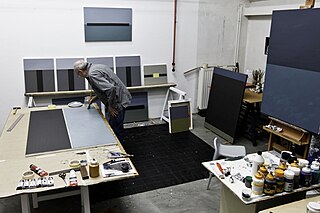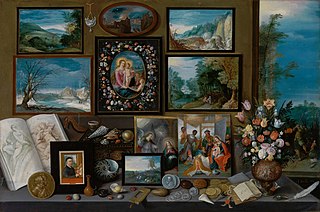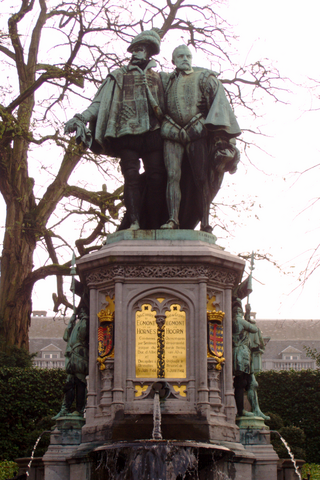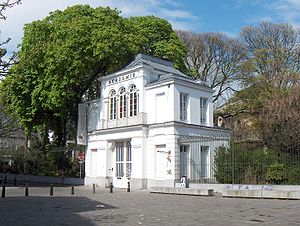
Philip Fruytiers (1610–1666) was a Flemish Baroque painter and engraver. Until the 1960s, he was especially known for his miniature portraits in watercolor and gouache. Since then, several large canvases signed with the monogram PHF have been ascribed to him. These new findings have led to a renewed appreciation for his contribution to the Antwerp Baroque.

The Royal Museum of Fine Arts Antwerp is a museum in Antwerp, Belgium, founded in 1810, that houses a collection of paintings, sculptures and drawings from the fourteenth to the twentieth centuries. This collection is representative of the artistic production and the taste of art enthusiasts in Antwerp, Belgium and the Northern and Southern Netherlands since the 15th century.
Museum voor Schone Kunsten may refer to:

Eduard Salomon Frankfort was a Dutch Jewish painter during the late nineteenth and early twentieth centuries.
The Royal Academy of Fine Arts of Ghent is an art school that is one of the oldest art schools in Belgium. It is now part of the Hogeschool Gent.
Juliaen Teniers or Juliaan Teniers was a Flemish painter of figures and flower pieces. He was a member of the extended Teniers family of painters.

The Royal Conservatoire Antwerp is a conservatory of music, dance and drama in Antwerp, Belgium. It was founded in 1898 as the Royal Flemish Conservatoire by the Flemish composer Peter Benoit.

The Royal Flemish Academy of Belgium for Science and the Arts is one of an independent learned society of science and arts of the Flemish Community in Belgium. It is one of Belgium's numerous academies and traces its origin to 1772 when the Imperial and Royal Academy of Brussels was founded by empress Maria Theresia.
The Royal Academy of Science, Letters and Fine Arts of Belgium is the independent learned society of science and arts of the French Community of Belgium. One of Belgium's numerous academies, it is the French-speaking counterpart of the Royal Flemish Academy of Belgium for Science and the Arts. In 2001 both academies founded a joint association for the purpose of promoting science and arts on an international level: The Royal Academies for Science and the Arts of Belgium (RASAB). All three institutions are located in the same building, the Academy Palace in Brussels.

Jan Baptist Martin Wans or Jan Baptist Wans was a Flemish Baroque painter known for his landscapes and religious scenes.
Aglaia Konrad is an Austrian photographer and educator living in Brussels.

Luc Piron is a Belgian artist. He is a painter and printmaker. He is also a photographer and experiments with the possibilities of computer art.

Bart Cassiman (1961), is an international freelance-curator, art critic and editor, is an art historian and studied press- and communication sciences at the Ghent University (1979-1984).

Samson Mocked or The Mockery of Samson is an oil-on-canvas painting by Jan Steen, created c. 1670, now in the Museum of Fine Arts, Antwerp.

AP University of Applied Sciences and Arts Antwerp, founded in 2012, is a non-profit public higher education institution located in the city of Antwerp and created as a merger between Artesis Hogeschool Antwerpen and Plantijn Hogeschool [1] [2].

A Cabinet of Curiosities is a 1619 oil on panel painting of a cabinet of curiosities by the Flemish painter Frans Francken the Younger. It is now in the Royal Museum of Fine Arts, Antwerp, which bought it in 1903 from the Antwerp-based art dealer Joseph Hallyn.

Laurys Gillis or Laurent Gillis was a Flemish sculptor who was active in Antwerp in the first half of the 18th century. He worked for a long time in the workshop of the prominent Antwerp sculptor Michiel van der Voort the Elder. He is known for statues of historical and biblical figures, Christian saints and allegorical respresentations.

Self-Portrait is an oil-on-canvas painting by the French Neoclassical artist Jean-Auguste-Dominique Ingres. The painting measures 25.2 x 20.9 inches and is part of the permanent collection of the Royal Museum of Fine Arts in Antwerp. This painting is one of the last portraits by Ingres.

Henri Boncquet was a Belgian sculptor.

Charles Auguste Fraikin was a Belgian neoclassical sculptor.
















